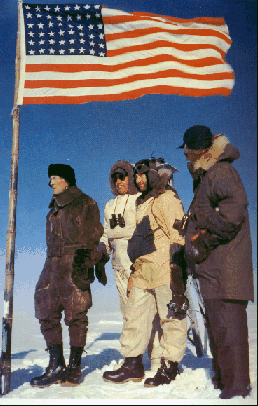|
Preliminary Reconnaissance
for Operation Deepfreeze
The icebreaker USS ATKA departed Boston, MA on December 1, 1954, proceeding
for Antarctica.
She arrived at the Bay of Whales and site of the former
Little America bases on January 14, 1955. At this time it was discovered
that the Bay of Whales no longer existed. Only sheer cliffs of ice appeared
where the Barrier had come together.
A large portion of the "tent"
city of Little America IV (OPERATION
HIGHJUMP / 1946-47) had calved off and floated
out to sea. A suitable site for Little America V (to be built during OPERATION
DEEPFREEZE I) was determined at Kainan Bay, about twenty miles
east of the earlier locations.
The arrival of the USS ATKA
at this point on the map was commemorated with a wide assortment of cacheted
mail...
Operation
Deepfreeze 1955-1998
Deepfreeze
II: Byrd (L); Siple (Next to Byrd)
|
OPERATION
DEEPFREEZE was planned in two stages. OPERATION DEEPFREEZE
I, in 1955-56 was designed to build an airfield at McMurdo
Sound. Another base was to be built near Little America in the Bay
of Whales. Seven ships and 1800 men participated in the first year.
OPERATION
DEEPFREEZE II, in 1956-57, was intended to build a permanent
station at the South Pole along with establishment of three other
IGY stations...Byrd station in Marie Byrd Land, Wilkes
station in Vincennes Bay and Ellsworth station on the Filchner Ice
Shelf.
Even
though Byrd was in command
of the operation, effective control of the operations were under
Rear Admiral George Dufek. Deepfreeze I was a resounding success
and with twelve ships and the assistance of 3400 men, Deepfreeze
II succeeded in the establishment at the
South
Pole.
Initially, a support base was built near the Beardmore
Glacier where supply planes returning from the pole could stop and
refuel. The base could also serve as an emergency rescue site.
At
the pole, the construction team built shelters, a power station
and workshops. Plane after plane dropped hundreds of tons of supplies
and equipment to make the base self sufficient.
Once completed,
the construction team was flown out and the scientific team flown
in to be the first humans to spend winter at the South Pole. The
station was completed in March 1947 and 18 men remained for the
long winter.
Chief of the scientific
staff at the South Pole was
Paul
Siple, who was 19 years old when he accompanied Byrd on his first
expedition in 1928. On September 18, 1957 the temperature reached
a record -107°F.
After 43 years, the Navy
officially withdrew from operations in Antarctica on February 20,
1998. Over the past three decades, most American operations in Antarctica
have been under the authority of the National Science Foundation,
although the Navy ran station kitchens, stores, security and transportation.
The science foundation has contracted these functions to a commercial
organization, Antarctic Support Associates, based in Denver, CO.
|
At a
special ceremony on February 20, 1998 in Christchurch, New Zealand, responsibility
was reassigned from the US Navy to the 109th Airlift Wing of the New York
Air National Guard.
This unit, based in Scotia, New York, has regularly
flown logistical support missions for military and scientific research
facilities at the North Pole and on the Greenland ice sheet.
The National
Science Foundation's US Antarctic Program currently maintains the
McMurdo Station facility and the Amundsen-Scott South Pole Station.
The
use of special ski-equipped LC-130 cargo planes by the 109th has allowed
the foundation to conduct research to a greater extent than any other
nation at sites across the Antarctic continent in fields including glaciology,
earth science, biology, oceanography, meteorology and astrophysics.
|
